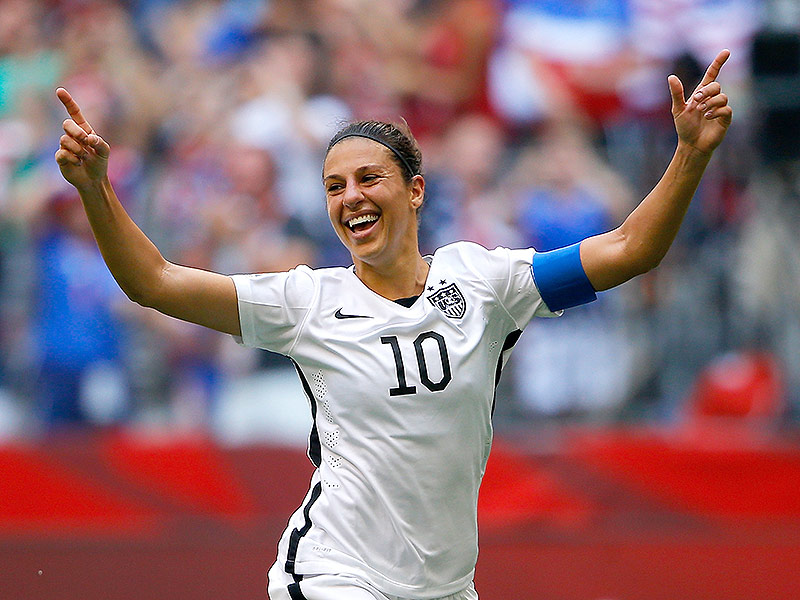Why Carli Lloyd’s Instagram Account Is The Key To Growing Soccer Interest In The U.S.

The United States Women’s National Team won on and off of the soccer pitch on Sunday night. 26.7 million Americans tuned in on Sunday night to watch the Americans beat Japan in the 2015 FIFA Women’s World Cup. That more Americans tuned in to watch this soccer match than any other in American history is significant to the growth of the game’s popularity in the U.S. going forward.
A handful of factors contributed to the widespread viewership of the 2015 FIFA Women’s World Cup final game. For instance, being played during primetime hours likely swayed more American viewers to tune in. Beyond that, some Americans may have tuned in during Independence Day weekend to show patriotism as their country’s national team fought for a world title. Yet, there is likely more to the widespread viewership of the game than the timing of the game.
One thing that may have driven the high viewership numbers is the marketability of the 2015 U.S. Women’s National Team. Coming into tournament play, high expectations were placed on the team’s success. Driving those expectations in part was the return of several key starters from the 2011 team to this year’s team. Coming off of the 2011 Women’s World Cup, several of these starters, ranging from Alex Morgan and Hope Solo, have managed to stay in the public limelight. Through marketing deals and news stories, these women have helped the national team stay in the public spotlight in non-tournament years and subsequently helped generate public interest in the team.
Beyond staying in the limelight through marketing deals, though, many members of the 2015 United States Women’s National Team kept interest in the team afloat through their significant social media followings. For instance, Hope Solo has 979,000 followers on Twitter, whereas Alex Morgan has 1.6 million Instagram followers and Carli Lloyd has nearly 350,000 Facebook fans. The team’s significant social media followings may have played a role in viewership of the 2015 FIFA Women’s World Cup final rising 77 percent over 2011’s viewership numbers.
European soccer leaders believe that strong digital presences are key to growing the sport’s popularity in the 21st century. Take for instance, the Bundesliga. Earlier this year, the German soccer league made news when it began broadcasting its games for the first time in the United States, thanks to a partnership with Fox. In selecting a media rights partner, the Bundesliga wasn’t just concerned with the financial aspect of the deal, but in how different media partners could assist its international growth strategy, which relies in part upon a strong social media presence.
“If you have growth potential internationally, the media strategy is important so that people can see your product wherever possible in the world,” said Jörg Daubitzer, the managing director of DFL Sports Enterprises, which oversaw the sale of the Bundesliga’s media rights to Fox.
For Daubitzer and the Bundesliga, contingent to signing a media rights deal was a partner’s ability to help grow the league’s brand digitally. “Our search for an American media rights partner began a few years ago when we saw that the Bundesliga was developing in international markets very positively. We thought it was time to find the right partner who reflected this growth opportunity and perspective,” he noted.
One thing that attracted the league to Fox, was the Bundesliga’s belief that Fox could help manage its digital assets. “Fox has proven over many years that they are able to work with and handle big properties. They’ve proven that their able to help brands build up their value, especially in the United States,” Daubitzer said.
For American teams and leagues seeking to build their fan base and national presence, Daubitzer believes that a solid digital strategy is necessary. “The most important aspect will be to use the new digital opportunities to get in contact with soccer fans worldwide and communicate directly with them. In the past, it was always necessary to speak to fans via a third party. The biggest opportunity for all properties in sport is the ability to communicate with fans directly through digital media,” he argued.
In the next four years, it’s important that the stars of this year’s United States Women’s National Team find their way to being featured on cereal boxes and shoe ads. Yet, if this year’s roster is serious about growing the game of soccer nationally, building strong and meaningful digital presences may be the quickest and most effective way to accomplish that goal. Thus, let the tweets and selfies on Instagram commence!
Get the free weekly newsletter so you can win the game.
